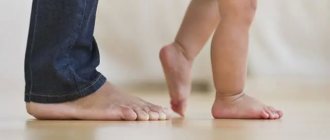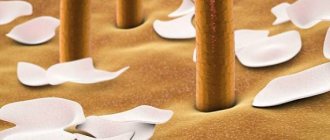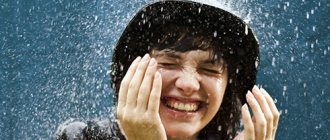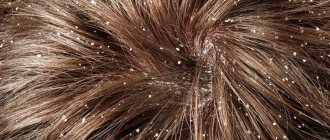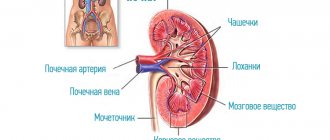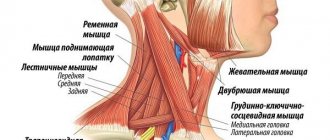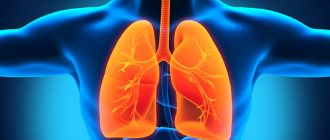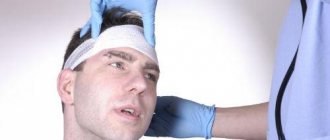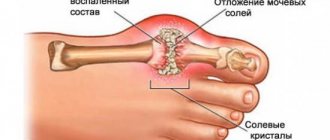Seborrhea of the scalp is a skin disease that occurs in areas rich in sebaceous glands. It manifests itself in inflammation of the scalp and other areas and can occur in either a mild form or develop to severe forms of dermatitis. Seborrhea occurs during adolescence and is most common in teenagers and older adults. Men are more likely to suffer from seborrhea than women.
Scientists are still debating the reasons for the development of seborrhea. Despite the fact that seborrhea affects the skin on areas of the head rich in sebaceous glands, it is not a disease of these glands. In patients with seborrhea of the head, the microflora of the skin and the balance of bacteria living on it are disturbed. The predominance of certain types of rain fungi that colonize the skin can lead to disruption of the lipid composition of the skin and the development of irritation. Seborrheic dermatitis is not only an aesthetic problem. With dermatitis, the skin becomes inflamed, itchy, and keratinizes faster. The scalp becomes crusty, seborrhea becomes visually visible and requires special treatment.
Seborrheic dermatitis: what contributes to its development
Seborrhea affects the head and other areas of the body more often if there are accompanying conditions:
- increased skin oiliness;
- life with stress;
- lack of sleep;
- evidence of scalp seborrhea in relatives;
- lymphoma, HIV and other diseases that cause a state of immunosuppression;
- diseases of the nervous system;
- psychical deviations.
Seborrhea develops more often in the presence of these factors, but the reasons for the development of the disease are not completely clear. Seborrheic dermatitis is not a disease of the sebaceous glands, although it develops in areas of the head saturated with them.
A significant role in the development of the disease is played by yeast-like fungi of the genus Malassezia (they inhabit the skin of most healthy people, but in some cases can cause rashes and irritation), the composition of lipids on the skin surface, as well as the characteristics of the immune response to Malazessia fungi and their metabolic products. Regardless of the causes of dermatitis, special measures are required for the scalp. The duration of such treatment can be from two months to six months, and after defeating dermatitis, maintenance therapy is needed for the epidermis of the head, which will prevent the re-development of seborrhea in any part of the body or head.
Causes of seborrhea of the scalp in adults
Human skin is the first protective barrier against adverse external influences. Therefore, disturbances in the functioning of the sebaceous glands can be the result of both internal malfunctions in the functioning of organs and systems, and external factors - unfavorable environmental conditions, employment in enterprises with hazardous working conditions, improper care of hair and scalp.
The most common causes of seborrhea in adults are:
- hormonal changes;
- hormonal imbalances;
- hereditary predisposition;
- immunodeficiency states;
- mental disorders;
- chronic fatigue, poor nutrition and vitamin deficiency;
- long-term use of hormonal or anabolic drugs.
Features of seborrhea
Does seborrheic dermatitis only affect the scalp? No, this disease can occur on different parts of the human body. Treatment methods will differ depending on the location of the areas affecting the head, chest, back or other parts of the body.
Seborrheic dermatitis, which develops on the head or other parts of the body, is characterized by periods of exacerbations and remissions. Its treatment should take place in several stages and include maintenance therapy against seborrhea. The entire treatment regimen should be coordinated with a doctor in order to achieve maximum results and normalize the condition of the scalp in the shortest possible time, as well as prevent the development of seborrhea and dermatitis.
When treating any form of seborrhea, special care products are used, as well as oils or creams to soften the crusts. It is important to stop the itching so that there is no desire to scratch the scalp and thereby further aggravate seborrhea. Scratching can open the door to secondary infection, and the scalp will have to be treated for several diseases at once.
Folk remedies
In addition to medicinal shampoos, folk recipes are successfully used to treat seborrheic dermatitis. Good reviews of celandine in the treatment of seborrhea. Prescriptions should be in combination; traditional recipes do not exclude, but complement the intake of medications. The use of herbs and essential oils is effective. Baking soda also helps with scalp seborrhea. A variety of masks and lotions help to quickly restore the affected areas of the skin.
Excess sebum causes the development of oily seborrhea, while lack of production leads to dry dermatitis. Therapeutic therapy in both cases requires individual selection of special means after the examination. Specialists will determine the cause of dermatitis and prescribe comprehensive treatment.
You should not try to solve the problem on your own; even traditional recipes are best discussed with a cosmetologist. Among the salon procedures that help in the treatment of seborrhea, it is worth highlighting mesotherapy and darsonvalization. These procedures are included in the range of services at our salon. Sign up for a consultation, and our specialists will definitely help you restore the beauty and shine to your hair.
Head and hair care products as a treatment for dermatitis
Skin care products for the scalp, body, and hair for seborrhea should solve the following problems:
- relieve itching and soothe the scalp;
- suppress the growth of fungal flora on the head;
- provide a gentle, gentle cleansing of the scalp.
In some cases, treatment is supplemented with oral agents - antifungal drugs and others. Treatment using topical corticosteroids is also possible, but this treatment is used for a short time and only as prescribed by a doctor.
Photo
The photo shows what oily seborrhea of the head looks like.
The disease requires mandatory treatment.
Treatment of seborrheic dermatitis should be comprehensive. An ideal combination of medicinal shampoos and antifungal drugs.
Means and preparations
Before treating seborrhea of the scalp, the cause of the disease should be established. The disease is provoked by the following factors:
- gastrointestinal dysfunction;
- hormonal imbalances;
- increased or decreased sebum secretion.
In addition to drug therapy, treatment of seborrhea of the scalp involves adjusting the diet, taking medications, as well as physical therapy to restore the condition of the skin.
Pills
Patients are prescribed medications for scalp seborrhea:
- Androcur;
- Loratadine (course from 7 to 60 days);
- Triamcinolone (to relieve inflammation);
- Selevit or Triovit (zinc-containing drug).
While taking tablets for seborrhea of the scalp, it is recommended to abstain from alcoholic beverages.
Nutrition adjustments
A therapeutic diet helps cleanse the intestines of toxins, increasing the overall resistance of the body, which prevents the growth of bacteria. The therapeutic diet involves split meals in small portions every two to three hours. The menu is based on a combination of vegetables, berries, fish and lean meats, cereals and grains. It is necessary to exclude the consumption of alcohol, carbonated drinks, processed foods, marinades, potatoes and baked goods. Fatty, fried and spicy foods are prohibited.
Shampoos
Shampoos for oily seborrhea of the scalp have an antifungal effect. You can buy medicated shampoo for seborrhea "Mustela" at the pharmacy. The duration of the course is one month. To prevent illness, the drug is prescribed once every two weeks. Good reviews about the “Keto+” seborrhea shampoo. It has a mild effect with high efficiency.
Shampoo for seborrhea “Cinovit” helps restore the functions of the sebaceous glands, which leads to normalization of sebum production. Cynovit is used several times a week, the foam is thoroughly rubbed into the roots for one minute. After two minutes, the product is washed off. The course of treatment with shampoo with zinc for seborrhea is 4 weeks.
Shampoos for oily seborrhea and hair loss, along with a therapeutic effect, help restore the hair structure. After the course of treatment, the strands become shiny, silky and voluminous.
Medicinal shampoo "Alerana" for seborrhea is an antifungal agent. Its regular use stops the growth of pathogenic organisms. The duration of therapy is determined by the doctor, usually a monthly course is prescribed.
Seborrhea cream
Sebozol - a cream for seborrhea of the scalp relieves inflammation, prevents the growth of pathogenic bacteria, stimulates blood flow in the head and improves the condition of the hair structure. For maximum effectiveness, the product is applied locally to damaged areas twice a day. The approximate course is 4 weeks; more precise prescriptions will be made by the attending physician.
Mycozoral ointment for seborrhea of the scalp will relieve dermatitis in just a month of treatment. The cream should be applied carefully so as not to affect healthy areas of the skin, this will prevent the appearance of hives and burning. Medicine for seborrhea of the head is used no more than twice a day. Course 4-8 weeks.
Sulfur ointment for seborrhea of the scalp shows the greatest effectiveness in combination with shampoos and antifungal drugs taken orally.
Ointment for dry seborrhea on the head “Skin-up” promotes the rapid restoration of damaged skin, and also stimulates the functioning of the rock glands, and relieves irritation. Salicylic ointment for scalp seborrhea is applied to the affected area in a thin layer and rubbed into the skin with light movements. The duration of use depends on the severity of the disease: from two to six weeks.
Balms
The Gestil line has a high price. The balm has good reviews and shows high effectiveness in the treatment of seborrheic dermatitis. In addition, the use of the product significantly improves lymph microcirculation and blood flow. The hair follicle is restored, the hair becomes healthy and elastic. The balm is applied for 15 minutes, two to three times a week, to clean and always damp hair. You can use it for prevention even after completing the treatment course.
Belita Vitex with pepper is a complex of active components to suppress pathogenic bacteria, normalize the production of sebaceous fat and stimulate hair growth. The balm is used three times a week, applied to the scalp for 10-25 minutes. The duration of use is not limited.
Diagnosis of dermatitis
In the An-Tek Laboratory, before treatment of skin dermatitis, the patient undergoes diagnostics. A trichologist will evaluate the condition of the skin on the head, the features of its scalp, and use a trichoscope to study the structure of the hair, its thickness and other characteristics. With seborrhea, a clinical picture is enough to make a diagnosis: when prescribing treatment, the doctor will make sure that the patient really has seborrhea, and not other diseases with similar symptoms - rosacea, lichen, psoriasis, eczema and others.
The first recommendation to the patient is to use a special shampoo for the head, indicated for the treatment of seborrhea and dermatitis. However, this remedy alone may not be enough to return the skin to its normal state. In this case, the doctor will resort to active general treatment. Seborrhea responds well to the use of local remedies, but an integrated approach is always more effective.
Effective assistance from professionals
There are a lot of remedies for the treatment of seborrheic dermatitis, but they do not always give the expected result. If you want to get rid of an unpleasant defect forever, visit one of the Apriori salons. We have excellent specialists with extensive experience who can help solve the problem by finding out the causes and characteristics of the disease. To combat seborrhea, we use procedures that in practice give the best results:
Hair mesotherapy has long been used in medicine as an effective technique aimed at improving the condition of the skin, eliminating inflammatory processes and defects. Thanks to injections, the deep layers of the epidermis are able to replenish the lack of nutrients. Therapeutic cocktails activate metabolism and help deliver oxygen to cells, which stimulates recovery processes. For each client, the master selects a combination of drugs individually.
Darsonval is popular with our clients, because exposure to current pulses provides an excellent effect. The skin recovers, the symptoms of seborrhea gradually disappear. A distinctive feature of the procedure is the ability to simultaneously use masks and cosmetics, which greatly enhances the effect.
The results of the first and second procedures will be noticeable after the first 2-3 sessions. The duration of the course is determined by the master. Professionals at Apriori salons offer to use their services not only to eliminate existing problems, but also for preventive purposes.
Scalp care for seborrhea
What rules should be followed during the treatment of seborrhea? The doctor always gives individual recommendations for scalp care, but the general list can include:
- adherence to the principles of healthy eating not only during the period of exacerbation of seborrhea, treatment or during the period of remission of seborrhea, but also on an ongoing basis;
- daily use of skin and hair gel to reduce oiliness and remove dead particles;
- cleansing dry scalp three times a week;
- ensuring optimal humidity and air temperature in the apartment.
At the An-Tek Laboratory, seborrheic dermatitis is treated by specialized doctors - trichologists, who are well acquainted with the peculiarities of seborrhea, its forms and the nuances of treatment.
We use effective topical medications and offer patients advanced treatment methods. Back to list of articles
How to get rid of oily dandruff forever
Treatment for oily dandruff largely depends on the cause of the disease. If the disease appears due to hormonal disorders, the doctor prescribes various medications that normalize the ratio of female and male hormones. If the cause of the development of seborrhea is reduced immunity or diseases of the internal organs, a prescription is written for immunomodulators, vitamins, mineral and selenium-containing complexes.
It is important to understand that it is impossible to get rid of oily dandruff solely with the help of folk remedies. Treatment involves complex therapy carried out under the supervision of an experienced trichologist.
As a rule, patients are prescribed:
- Medications.
To successfully treat oily dandruff, patients are prescribed calcium, zinc and hormonal medications, which are selected individually. - Correctors for sebum production.
The doctor prescribes the patient various sulfur-containing ointments, boric acid, and salicylic acid. These drugs prevent the accumulation of sebum and reduce inflammation of the glands. - Antifungal drugs
inhibit the growth of the fungus, destroying its structure. - Sebum production blockers
are prescribed for hormonal disorders. The antiandrogenic properties of the drugs help stop the disease.
An effective care product in the fight against oily dandruff is ALERANA® shampoo. The product stimulates cellular metabolism in the follicles, blocks the proliferation of fungus and increases the access of oxygen to the hair follicles.
Additionally, treatment can be accompanied by homemade masks, which are also suitable for preventing oily dandruff:
- Herbal mask.
Ingredients: oak bark, nettle, mint, sage, hop cones (one tablespoon of each ingredient). Pour all this into 0.5 liters of boiled hot water and steam in a water bath for 20 minutes. Then cool, strain the liquid, add 200 grams of vodka or cognac, 1 tablespoon of vinegar. The mask can be made in reserve and stored in the refrigerator, but warmed up before application. Rub the finished mixture into clean scalp and rinse off after two hours with warm water and anti-oily dandruff shampoo. - Homemade lotion with pepper.
Dilute 1 tablespoon of pepper tincture with one tablespoon of water, add a teaspoon of lemon juice and 15 drops of lavender oil. Apply the product to clean scalp a couple of hours before bedtime and cover with film. After an hour, the film should be removed and the head should be allowed to dry. You can wash your hair only in the morning.
Onion mask.
Mix the juice of one onion with two tbsp. spoons of mustard powder and dilute with hot water to the consistency of sour cream. Add 1 tablespoon of aloe vera extract, an ampoule of vitamins B1 and B6, one yolk, one tablespoon of honey. Apply the resulting composition to the hair roots and leave there for an hour under a film or towel.- Lemon
will also help get rid of oily dandruff faster. A decoction should be prepared from the sunny fruit. For a liter of water you need to take the peel of 4 lemons, cut into pieces. The zest is filled with water and placed on the stove. As soon as the broth boils, reduce the heat and simmer the mixture for 25 minutes. After cooling the broth, do not forget to strain it through a sieve. Every week, it is recommended to rinse the curls with the resulting liquid and massage the scalp during the procedure.
Calendula
will not only help get rid of dandruff, but also strengthen the hair follicles and improve their appearance. To prepare the mask, take a tablespoon of chopped marigolds and pour two cups of boiling water. The barely warm infusion should be rubbed into the scalp and put on a plastic cap. After 40 minutes, you can remove the thermal coating and go to bed without washing off the mask.
How to get rid of dandruff quickly?
Unfortunately, it is impossible to quickly get rid of oily dandruff forever. Treatment of the disease involves the methodical implementation of procedures, a review of lifestyle and hair care. But what to do if you find an unpleasant “snowfall” on your clothes, and in a few hours you have a fateful meeting?
The following remedies will help you urgently get rid of oily dandruff for a few hours:
- Rinse with herbal decoction.
A thick decoction should be prepared from one tablespoon of coltsfoot herb, nettle, burdock rhizome and three tablespoons of water. Herbs normalize the water balance of the skin and stop the growth of the fungus for several hours. - Scalp massage.
An active massage for 7-8 minutes will help stop the unpleasant “snowfall” for a while. When washing your hair, carefully massage the scalp without damaging the skin. This will help for a while - Salt
can also help get rid of oily dandruff for a few hours. Take 2-3 tablespoons of coarse sea salt and rub the grains into dry skin. You need to rub the substance until the salt is completely dissolved. Then be sure to wash your hair with shampoo.
Acne classification
A
.
Constitutional acne 1. Seborrheic acne in childhood adolescence and adolescence: - acne of newborns - acne of infants - juvenile acne 2. Late acne: - premenstrual acne - postmenstrual acne - late hyperandrogenic acne in women - conglobate cystic acne in
men
B. Provoked acne 1. Artificial acne (mechanical, traumatic) 2. Oil acne (including professional acne) 3. Cosmetic (can be considered as a contact variant, usually found in women 20-30 years of age who abuse cosmetics). 4. Excoriated (In most cases, it manifests itself in a mild form. Each new rash is squeezed out, scratched or processed with some instrument. A smooth transition of this acne into a disease with abnormal neurotic behavior is possible. Some authors distinguish three degrees of severity of acne: mild form acne is diagnosed mainly in the presence of non-inflammatory elements - closed and open comedones. The moderate form is characterized by the presence of papulopustular elements on the face and torso. The severe form is characterized by a large number of papulopustular elements, as well as conglobate and cystic forms of acne. In recent years, acne treatment has been carried out taking into account pathogenetic aspects and therefore has become more targeted. Diet
... Food does not affect the amount and composition of sebum and the processes of keratinization of follicles. However, individual observations of patients should be taken into account.
Psychotherapy
... Patients with acne often suffer from disfiguring facial changes.
Acne is not caused by mental factors. Acne therapy itself is based on effective therapy, and not on psychotherapy. Psychotherapy that accompanies treatment can help in certain situations. Drug treatment
. Local and systemic therapy is used to treat acne. Topical treatment is indicated only for mild to moderate non-inflammatory acne, mild inflammatory acne without scarring, and as adjunctive therapy for moderate to severe acne. The most actively used drugs, both systemic and local, are retinoids. They act on follicular hyperkeratosis. Retinoids are universal inhibitors of lipogenesis and sebum secretion, normalize keratinization processes, and reduce the inflammatory response. The most well-known drugs are: tretinoin, airol, differin, isotretinoin, lokatsid, retin-A, clinesfar. An isotretinoin derivative, roaccutane, is used as a systemic drug. In addition to retinoids, you can influence excess sebum production with the help of antiandrogenic substances. Most are oral medications. The most famous are: Androcur, Diane-35, spironolactone. The latter can be used in 3-5% concentration, but it, as a rule, has a weak therapeutic effect. Microbial colonization of the follicle is affected by antibiotics and antiseptics, which are used both as local agents and internally. The most commonly used are tetracycline, erythromycin, and clindamycin. One of the options for local anti-inflammatory treatment of acne is curiosin gel. It contains natural components - hyaluronic acid, zinc, substances that are part of many tissues of the human body, primarily the skin. The drug is recommended by manufacturers for the treatment of any form of acne, however, as a result of long-term observations of the practical use of the gel, a lack of clinical effectiveness in its use has been established. In addition to specific local and systemic drugs that affect the pathogenesis of acne, patients often require additional measures (adjuvant therapy).
What can cause seborrhea of the scalp in children
Seborrhea in newborns is considered a natural physiological process, caused by increased activity of the sebaceous glands. But, if bleeding, redness and itching of the skin occurs or if the disease lasts for a long time (more than 14 months), you should immediately consult a doctor.
Seborrhea of the scalp in children over one year old can be caused by:
- improper nutrition of the mother (if the child is breastfed) or the child;
- unfavorable temperature conditions - if the room is too hot or the child is dressed too warmly;
- allergies to food or hygiene products;
- failure to comply with hygiene rules;
- taking antibiotics or other medications;
- metabolic disorders;
- decreased immunity and hypovitaminosis;
- stress;
- hormonal disorders;
- diseases of the endocrine system.
Introduction
All over the world, acne (acne) is considered one of the most common diseases. While it is seen by some as a cosmetic defect, there are few diseases that cause so much physical and mental suffering, especially during adolescence. There are usually no problems in making a diagnosis, but there are large discrepancies between causative factors and effective treatments. There are several types of sebaceous follicles: 1. Terminal hair follicles (found in the hair of the beard, eyelashes, eyebrows). With inflammation in their locations, inverse acne develops. 2. Follicles of the vellus glands (vellus hair). Most likely, these glands are not involved in the development of acne. 3. Sebaceous follicles, which are characteristic of humans and are not found among animals. They are localized in the face, neck, shoulders, back, and chest. The sebaceous follicle is the only type of follicle that can transform into acne. The sebaceous glands produce oil, which is used to lubricate the surface of the skin. The secretion of the sebaceous glands first accumulates in the hair sebaceous unit. Next, the secretion of the sebaceous glands is released onto the surface of the skin and, mixing with the lipids of the epidermis, forms sebum. With the onset of androgen hormonal stimulation, around the 7th year of life, the secretion activity of the sebaceous glands increases. With age, in people over 40 years of age, it decreases, especially in women during menopause. Sebum secretion follows a circadian rhythm, rising in the morning and decreasing in the evening. The composition of sebum includes free and bound fatty acids; triglycerides, metabolites of steroid hormones, squalene, cholesterol, wax esters, phospholipids, and carotene are found in small quantities. Sebum secretion is regulated by neurogenic (autonomic nervous system) and humoral (hormonal regulation) mechanisms. Stimulate sebum secretion: adrenocorticotropic hormone, adrenal hormones, androgens. Estrogens suppress sebum secretion. There is a condition called SEBORRHEA
- a painful skin condition associated with excess production of sebum by the sebaceous glands with an altered chemical composition. There is an undeniable connection between seborrhea and acne. But hypersecretion of sebum is not enough to explain the development of acne, since hyperseborrhea can be observed without acne. However, acne is always accompanied by hyperseborrhea, and the more sebum the sebaceous glands produce, the more severe the acne. Pathological changes in seborrhea are associated with quantitative and qualitative changes in sebum. With increased sebum production in areas rich in sebaceous glands, the skin usually becomes very shiny and becomes covered with a sebaceous film. The shine of this sebaceous-sweat film cosmetically disrupts the appearance of the face. With seborrhea, the composition of sebum changes significantly. Compared to healthy individuals, patients with seborrhea experience an increase in androgens in sebum and a decrease in estrogens. With seborrhea, the concentration of linoleic acid in sebum decreases, which leads to an increase in skin pH, changes in epithelial permeability, and the growth of microorganisms on the surface of the skin.
Vulgar acne
One of the most common skin diseases, affecting up to 85% of people aged 12 to 25 years and 11% of people over 25 years of age. Acne can lead to disfigurement and permanent scarring. But even mild cases cause significant emotional distress and have serious psychosocial consequences. Acne is a disease of the hair follicles and sebaceous glands. Four interrelated factors are important in pathogenesis: 1. Pathological follicular hyperkeratosis
– this is a violation of the processes of keratinization, which leads to blockage of the follicular duct by horny scales and the formation of a comedon (black head).
Subsequently, closed comedones turn into inflammatory papulopustular elements and transform into open comedones. In closed comedones, the drainage of sebum and waste products of Propionibacterium acnes is completely blocked. The created oxygen-free conditions are an optimal environment for the rapid proliferation of microorganisms. 2. Excessive formation of sebaceous gland secretion
, which is a substrate for the proliferation of P.acnes, and also leads to pronounced cosmetic defects due to the formation of deep sebaceous cysts (atheromas).
3. Microbial colonization
, in particular the proliferation of P. acnes.
4. Inflammation and immune response
. Acne is not a primarily immune disorder. P.acnes causes inflammation in the dermis (deep layers of the skin), and the epithelium (surface layers of the skin) is damaged by proteolytic enzymes. First, migration of lymphocytes occurs at the site of inflammation. Neutrophilic leukocytes penetrate the lesion and it is they who contribute to even greater damage to the follicle epithelium as a result of lytic enzymes. Highly active radicals (oxygen free radicals, hydroxyl groups, hydrogen peroxide superoxides) accumulate in the dermis, which further damage cells and support inflammation. Inflammation develops at any stage of acne. Today there is no single classification of acne. Existing classifications of acne are based on the clinical picture of the disease or on an assessment of its severity. The most successful is the etiopathogenetic classification. In this review, it is presented with the aim of expanding the understanding of this problem, which will allow us to determine the significance of the disease and optimize the creation of drugs for local and systemic use for the above-mentioned disease.
